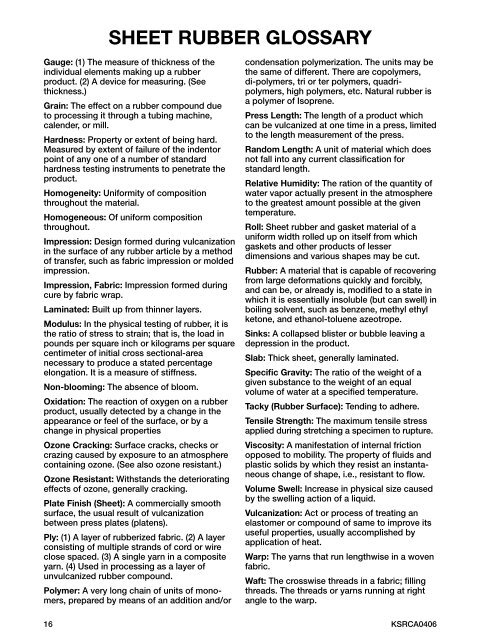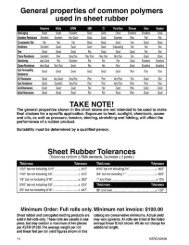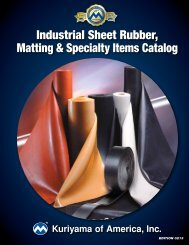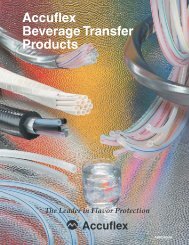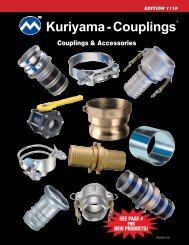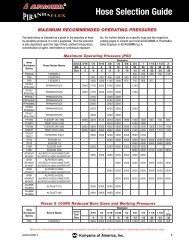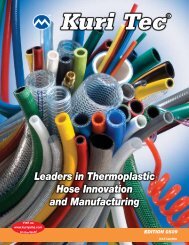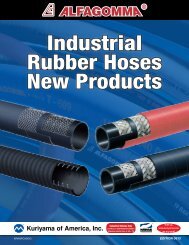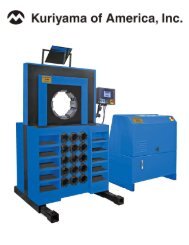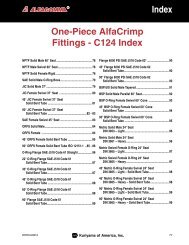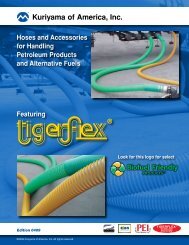specifications - Kuriyama of America
specifications - Kuriyama of America
specifications - Kuriyama of America
Create successful ePaper yourself
Turn your PDF publications into a flip-book with our unique Google optimized e-Paper software.
SHEET RUBBER GLOSSARY<br />
Gauge: (1) The measure <strong>of</strong> thickness <strong>of</strong> the<br />
individual elements making up a rubber<br />
product. (2) A device for measuring. (See<br />
thickness.)<br />
Grain: The effect on a rubber compound due<br />
to processing it through a tubing machine,<br />
calender, or mill.<br />
Hardness: Property or extent <strong>of</strong> being hard.<br />
Measured by extent <strong>of</strong> failure <strong>of</strong> the indentor<br />
point <strong>of</strong> any one <strong>of</strong> a number <strong>of</strong> standard<br />
hardness testing instruments to penetrate the<br />
product.<br />
Homogeneity: Uniformity <strong>of</strong> composition<br />
throughout the material.<br />
Homogeneous: Of uniform composition<br />
throughout.<br />
Impression: Design formed during vulcanization<br />
in the surface <strong>of</strong> any rubber article by a method<br />
<strong>of</strong> transfer, such as fabric impression or molded<br />
impression.<br />
Impression, Fabric: Impression formed during<br />
cure by fabric wrap.<br />
Laminated: Built up from thinner layers.<br />
Modulus: In the physical testing <strong>of</strong> rubber, it is<br />
the ratio <strong>of</strong> stress to strain; that is, the load in<br />
pounds per square inch or kilograms per square<br />
centimeter <strong>of</strong> initial cross sectional-area<br />
necessary to produce a stated percentage<br />
elongation. It is a measure <strong>of</strong> stiffness.<br />
Non-blooming: The absence <strong>of</strong> bloom.<br />
Oxidation: The reaction <strong>of</strong> oxygen on a rubber<br />
product, usually detected by a change in the<br />
appearance or feel <strong>of</strong> the surface, or by a<br />
change in physical properties<br />
Ozone Cracking: Surface cracks, checks or<br />
crazing caused by exposure to an atmosphere<br />
containing ozone. (See also ozone resistant.)<br />
Ozone Resistant: Withstands the deteriorating<br />
effects <strong>of</strong> ozone, generally cracking.<br />
Plate Finish (Sheet): A commercially smooth<br />
surface, the usual result <strong>of</strong> vulcanization<br />
between press plates (platens).<br />
Ply: (1) A layer <strong>of</strong> rubberized fabric. (2) A layer<br />
consisting <strong>of</strong> multiple strands <strong>of</strong> cord or wire<br />
close spaced. (3) A single yarn in a composite<br />
yarn. (4) Used in processing as a layer <strong>of</strong><br />
unvulcanized rubber compound.<br />
Polymer: A very long chain <strong>of</strong> units <strong>of</strong> monomers,<br />
prepared by means <strong>of</strong> an addition and/or<br />
16<br />
condensation polymerization. The units may be<br />
the same <strong>of</strong> different. There are copolymers,<br />
di-polymers, tri or ter polymers, quadripolymers,<br />
high polymers, etc. Natural rubber is<br />
a polymer <strong>of</strong> Isoprene.<br />
Press Length: The length <strong>of</strong> a product which<br />
can be vulcanized at one time in a press, limited<br />
to the length measurement <strong>of</strong> the press.<br />
Random Length: A unit <strong>of</strong> material which does<br />
not fall into any current classification for<br />
standard length.<br />
Relative Humidity: The ration <strong>of</strong> the quantity <strong>of</strong><br />
water vapor actually present in the atmosphere<br />
to the greatest amount possible at the given<br />
temperature.<br />
Roll: Sheet rubber and gasket material <strong>of</strong> a<br />
uniform width rolled up on itself from which<br />
gaskets and other products <strong>of</strong> lesser<br />
dimensions and various shapes may be cut.<br />
Rubber: A material that is capable <strong>of</strong> recovering<br />
from large deformations quickly and forcibly,<br />
and can be, or already is, modified to a state in<br />
which it is essentially insoluble (but can swell) in<br />
boiling solvent, such as benzene, methyl ethyl<br />
ketone, and ethanol-toluene azeotrope.<br />
Sinks: A collapsed blister or bubble leaving a<br />
depression in the product.<br />
Slab: Thick sheet, generally laminated.<br />
Specific Gravity: The ratio <strong>of</strong> the weight <strong>of</strong> a<br />
given substance to the weight <strong>of</strong> an equal<br />
volume <strong>of</strong> water at a specified temperature.<br />
Tacky (Rubber Surface): Tending to adhere.<br />
Tensile Strength: The maximum tensile stress<br />
applied during stretching a specimen to rupture.<br />
Viscosity: A manifestation <strong>of</strong> internal friction<br />
opposed to mobility. The property <strong>of</strong> fluids and<br />
plastic solids by which they resist an instantaneous<br />
change <strong>of</strong> shape, i.e., resistant to flow.<br />
Volume Swell: Increase in physical size caused<br />
by the swelling action <strong>of</strong> a liquid.<br />
Vulcanization: Act or process <strong>of</strong> treating an<br />
elastomer or compound <strong>of</strong> same to improve its<br />
useful properties, usually accomplished by<br />
application <strong>of</strong> heat.<br />
Warp: The yarns that run lengthwise in a woven<br />
fabric.<br />
Waft: The crosswise threads in a fabric; filling<br />
threads. The threads or yarns running at right<br />
angle to the warp.<br />
KSRCA0406


